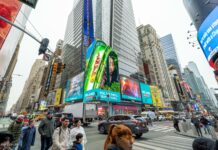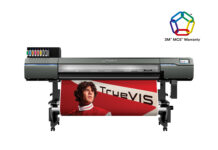Terry could be referring to any of the work his company has produced for sports complexes since he acquired the assets of Star Signs and Graphics in 2007 and renamed it Star Signs LLC.
The company’s signs are fixtures in such diverse sports destinations as Arrowhead Stadium (home of the NFL’s Kansas City Chiefs); Kansas City Speedway; the Superdome in New Orleans; M&T Bank Stadium (home of the Baltimore Ravens); ONEOK Field (home of minor league baseball’s Tulsa Drillers); Independence Entertainment Center in Independence, Missouri; and Southern Illinois University basketball and football stadiums in Carbondale, Illinois.
Although the arena work represents just one aspect of Star Signs’ business, it serves as a very public form of the company’s capabilities.
And it’s Star Signs’ many contributions to the newly renovated Kauffman Stadium (home of the American League’s Kansas City Royals baseball franchise) that may be the most visible and the best example of all that this multi-faceted sign specialist can achieve.
A Complex Project
Kauffman Stadium is also a case study of the complexities of a project on such a grand scale. “The sheer volume of signs—and different sign types—we had to produce was one of the major challenges,” says Star Signs Vice President of Sales Shelley Rosdahl.
Rosdahl estimates the company produced as many as 1,500 signs for the stadium. They ranged from the mundane (markers for seating and sections, restrooms, concessions, and directional guides) to the majestic (a custom-built twelve-foot-high and ten-foot-wide Royal’s crown for the stadium’s main team store).
Star Signs’ multi-faceted expertise is evident wherever fans look throughout the park: Forty-foot-tall “KC” letters, which announce the stadium to the city from behind the scoreboard; three-dimensional, custom-built graphics for the park’s Little Sluggers store and children’s play area; freestanding seven-foot-high letters at the entrance to the stadium’s Hall of Fame museum; and the many digital graphics that tell the Royals story inside.
“On large projects like this today, general contractors look for one company that can produce all the turnkey signage to their specs on schedule,” notes Terry. “It’s much easier for them to work with one company; we have all the capabilities something like this requires.”
Rosdahl adds, “You need to have a good-sized shop to manage all the work, as well as the people who are well organized in the planning, design, production, manufacturing, and installation.”
It’s not just sign printing and installing capabilities that matter. Whichever sign provider gets the contract must also have expertise in bid preparation and submission, local sign regulations and compliance, job site and labor requirements, and sign maintenance and replacement.
Past history can help. In this case, Terry reports Star Signs had done work for the sports facility specialists HOK Group in the past. (Note: HOK Group was renamed Populous in March 2009.) They were the architectural design and developers for the stadium redo, working with the Royals management and the general contractor, Hunt/Walton.
Plans called for an ambitious overhaul of the Royal’s Kauffman Stadium, originally built in the early 1970s, with a budget in the hundreds of millions.
Demonstrating Capabilities
Recognizing a potential opportunity for Star Signs in the earliest news reports of plans to redo the stadium back in 2007, Rosdahl started cultivating awareness among all involved that ultimately prepared her company to submit the winning bid. “For a project like this, you want to pre-qualify yourself with the general contractor well before the bidding process begins,” she explains. “Before anyone is invited to bid, they want to look at the size of your shop and its capabilities, [as well as] the types of projects you’ve done in the past to make sure you’re bonded and can handle the project.”
In the invitation to bid, Populous provided a letter outlining the scope of the stadium renovation and the preliminary number and location of signs with its bid forms. “They provided a design development package that’s very detailed but also pretty conceptual at that point,” says Rosdahl. “It included good drawings with dimensions of the different designs and what they should look like.”
At that point, there’s no guarantee of return for the time and effort the company must invest in the project. “Even after all the work done to prepare the bid, it can still take several hours just to complete the bid forms,” notes Rosdahl.
There’s little margin for error: Every cost, every potential challenge, and every special requirement must be taken into account for accurate cost projections. “Our estimator [Vice President for Pre-Production] Bob Underwood has twenty years’ experience at this and is very good at it,” says Rosdahl.
A Winning Bid
Apparently so, as Star Signs submitted the winning bid and was awarded the contract. The challenge then became designing the signs and planning and organizing actual production.
“Our shop drawings alone probably took three months before going back and forth for final approval,” points out Rosdahl. “For several sign types, we had to field-verify where they were going to be installed and make sure the plans they had given us would work.
“Occasionally the design or installation plans had to be modified before a project engineer would sign off on them.”
Rosdahl praises Star Signs Project Manager Stacee Martin for her many contributions. “She’s solely responsible for organizing things and making sure everything gets approved,” she says. “On a project this large, she’s the information manager too.”
Although plans called for signs to be installed as renovations were completed on different sections of the park, production was organized by the type of sign. “A major project like this takes priority to a point, but we’ve usually got a range of between twenty and forty projects going at any given time,” notes Rosdahl. “It worked best for us to fabricate by sign type and then warehouse the signs until they were needed.”
Star Signs’ pair of Mimaki digital presses were critical players on this job. The UV flatbed JF-1631 handled direct printing to Dibond®, aluminum, PVC, acrylic, and glass. Flexible media like vinyl banners, adhesive vinyl, and vinyl wall covering moved through Mimaki’s JV-3-130 SPII four-color continuous solvent printer.
Actual installation didn’t begin until December and proceeded through the cold winter months right up until Opening Day in April. Most installations were completed in February and March.
At peak, Star Signs had fifteen installers working full-time at the stadium. With so many signs and so many installations, this final phase of the project can be the true proving ground. “One of the toughest things about these projects can be the limited time frame,” admits Rosdahl. “You can work on it for a year, then have only a few months or weeks for the installation. That’s why project management is so huge to complying with the many deadlines.”
By Opening Day, everything was in place. Royals fan were treated to a new park experience, thanks, in part, to the many contributions of Star Signs. “High-profile jobs like this are a great marketing tool for us,” says Terry. “Because of the magnitude of the project and the wide variety of processes involved, it really shows people all we can do, and that can open doors for us.
“Everybody at our company was involved in some aspect of this project. It really was a team effort.”










